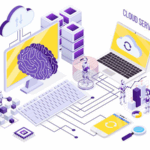Dominate 2025 with Next-Gen AI and ML Services for Future-Ready Growth
August 7, 2025 | 0 Comments
info@trickywebsolutions.com |
+1-225-276-2741
 USA
USA IN
IN
 SG
SG
 PT
PT
Nowadays, most companies have already implemented cloud-based solutions into their workflows to make their operations more efficient. But why are companies adapting cloud application architecture? One of the major reasons companies are turning to cloud based solutions is the several benefits they provide and the capability they have to keep up with the changing needs of organizations. Therefore, cloud-based application development has been on trend across companies for a couple of years. However, prior to implementing cloud application architecture, one must first know the difference between cloud native vs cloud based application development. Through this guide, we will learn what cloud-based and cloud native application development are, the main difference between cloud native vs cloud based applications, and the various advantages each method provides.
Cloud app development is the process of creating applications on cloud platforms using cloud based solutions instead of conventional servers. It involves several phases of the software development life cycle, each contributing to readiness for deploying the application. Most organizations nowadays opt for technologies that are specific to their needs. Most cloud applications rely heavily on the cloud environment to run successfully.
Cloud-based application development is nothing but a process of current applications being migrated into cloud architecture with some adjustments. While cloud-based applications utilize the cloud advantage, they tend to have delayed deployment and more interruptions. These applications were not created for the cloud environment in the first place, so they are likely to fail to maximize their potential.
Cloud native application development is the process of developing applications that are specifically designed for cloud environments. Today, businesses aim to create applications that are highly scalable, adaptable, and flexible to keep up with the evolving customer needs. They leverage microservices, containers, and DevOps practices to offer greater flexibility and scalability. Cloud native application development allows for frequent changes without disrupting other parts of the infrastructure.
Here are a few key differences between cloud native vs cloud based applications.
| Aspect | Cloud Native Apps | Cloud-Based Apps |
| Design | Cloud native apps are built natively for the cloud and use a microservices architecture to ensure adaptability and robustness. | These are initially developed for conventional systems, but are later migrated to a cloud environment. |
| Architecture | Microservices-based, loosely coupled | Monolithic or partially modular |
| Deployment Speed | Quicker deployment since there’s no need for hardware installation or software configuration. | Deployment may take longer due to the need to set up hardware or install necessary software. |
| Maintenance | Reduced disruptions as they are independently managed microservices that can be scaled or updated separately. | There is a higher risk of downtime due to tightly coupled components that often require full system updates. |
| Scalability | Cloud native apps are highly scalable | Less scalable as compared to cloud native applications. |
| Cost Effectiveness | Cloud native apps are more economical or cost-effective since you pay only for the cloud resources consumed. | It can be costlier due to inefficient use of cloud resources, resulting in unnecessary expenses. |
| Efficiency | Cloud native apps are highly efficient, with the capability to scale rapidly and adjust to evolving demands. | Efficiency may be restricted by possible downtime during updates and slower responsiveness to changes. |
| Examples | Real-time analytics apps, IoT apps, SaaS platforms, modern APIs | Legacy apps migrated to the cloud, traditional ERPs, or CRMs |
Here are some key benefits of implementing cloud native application development approach:
These applications are made so that they can progress according to business needs, without rigid dependencies binding users to one version of software. Following a loosely coupled architecture, cloud native app development approach helps organizations change or update any part of the architecture independently without affecting other parts of the system. For example, if you want to make changes in the front-end part of the software, you can easily do it with the help of cloud based solutions without changing the backend code.
Cloud native apps depend on the virtual infrastructure instead of relying on hardware servers, which minimizes and eliminates the need to depend on physical hardware. By adopting cloud native strategy, you can avoid implementing costly processors and memory with existing systems.
Developers can create applications that run consistently across a wide range of devices with the help of containers. This eliminates the need to modify the same code for different devices.
Here are some key benefits of a cloud-based application development approach:
One of the major benefits of implementing cloud-based applications is the reduced cost that businesses spend on expensive servers, processors, memory, and other physical hardware. By adopting a cloud-based application development strategy, businesses can save a lot as they don’t have to invest in such things; these will be provided by the cloud service provider. All they have to do is spend on the resources they are using.
Cloud-native applications depend on virtual infrastructure, which eliminates the need for implementing costly physical hardware. Rather than upgrading current servers with expensive processors and servers, this approach helps you provide the required resources in lesser price.
Cloud applications are easier to maintain than conventional ones. Cloud service providers address problems related to infrastructure at a quick and efficient pace, which reduces effort and disturbance for the user.
Choose cloud-native if:
Choose cloud-based if:
Recent Posts

Dominate 2025 with Next-Gen AI and ML Services for Future-Ready Growth
August 7, 2025 | 0 Comments

Scale Smarter in 2025: Why AI-Powered Cloud-Native Application Development is the Future
August 7, 2025 | 0 Comments

Your 2025 Guide to Next-Gen AI Development for Smarter Business Solutions
August 4, 2025 | 0 Comments

How to Create Cutting-Edge Blockchain Apps: A 2025 Development Guide
July 30, 2025 | 0 Comments

Boost Your Brand with Custom Mobile App Development Solutions
July 25, 2025 | 0 Comments

No Leads, No Sales? Here’s Why Your Website Isn’t Converting — and How to Fix It
July 24, 2025 | 0 Comments
Categories

We will zealously try to help you by providing technical support. We are open to inquiries or requests.
info@trickywebsolutions.com
1945 Brightside Drive, Baton Rouge, LA -70820
We are available for a friendly chat to discuss your business needs, no obligation.